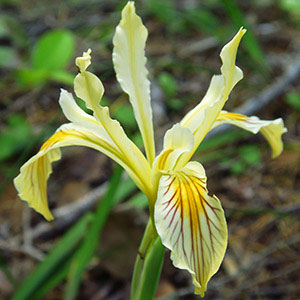Iris macrosiphon
Iris bracteata
bowltube iris, ground iris
Siskiyou iris
many-branched, forming tufts, with fibrous remains of old leaves at nodes, slender, 0.6–0.8 cm diam.;
roots few, fibrous.
sheathed with old leaf bases, slender, 0.6–0.9 cm diam.;
roots few, fibrous.
simple, solid, almost absent or to 2.5 dm.
simple, solid, 1.5–3 dm.
basal longer than stem, blade light green, finely veined, narrowly linear, 3–4 dm × 0.4–0.6 cm, glaucous, margins not thickened, apex acute;
cauline 1–2, spreading, sheathing for about 1/2 length, foliaceous, blade not inflated, 0.7–1 dm.
basal with abaxial surface of blades deep glossy green on one side of fan, light yellow-green on other side, pink or red-tinged basally, strongly ribbed, 4–6 dm × 0.8–1 cm, rigid, margins not thickened;
cauline 3–6, imbricated, closely sheathing stem ca. 2/3 length, spreading distally, bractlike, blade inflated, often shorter than basal leaves.
(1–)2-flowered;
spathes nearly opposite, connivent, linear-lanceolate, 4–9.5 cm × 4–6 mm, subequal or outer longer.
simple, units 1–2-flowered;
spathes closed tightly around pedicel and ovary, lanceolate, 5.2–9 cm × 6–8 mm, subequal, herbaceous, margins scarious, apex acuminate.
perianth indigo, purple, lavender, white, cream, or yellow;
floral tube linear, gradually dilating apically, 6 cm;
sepals usually with fine, dark veins basally, becoming coarser on claw, oblanceolate or obovate, 3.9–7 × 2 cm, base abruptly attenuate into claw;
petals oblanceolate, 3.5–6 × 0.5–1.6 cm, base gradually attenuate;
ovary ovoid, ca. 1 cm;
style 2–3.5 cm, crests overlapping, reflexed, semiovate, 0.8–1.8 cm, margins denticulate;
stigmas triangular, margins entire;
pedicel 1.5–2 cm.
perianth cream to buff-yellow;
floral tube 0.8–0.9 cm;
sepals with deeper yellow signal, veined with purple or brown, obovate-lanceolate, 6.5 × 2.5 cm, base gradually attenuate into wide claw;
petals narrowly oblanceolate, 7–9 × 0.8–2 cm, base gradually attenuate;
ovary nearly circular in cross section, 1.5–2.5 cm, base gradually attenuate into pedicel, apex abruptly acuminate into floral tube;
style 2.2–3 cm, crests spreading, yellow, not veined, 1.2 × 0.9–1.7 cm, margins toothed;
stigmas triangular or tongue-shaped, margins entire;
pedicel 3–6.2 cm.
oblong to ovoid, somewhat 3-angled in cross section, 2.5–3 cm.
nearly circular in cross section, tapering abruptly at each end, 2–2.5 × 1–1.5 cm.
dark brown, angular, finely wrinkled.
dark brown, irregular in shape, wrinkled.
= 40.
= 40.
Iris macrosiphon
Iris bracteata
Iris macrosiphon hybridizes with I. chrysophylla, I. douglasiana, I. fernaldii, I. hartwegii, I. innominata, I. munzii, I. purdyi, I. tenax, and I. tenuissima.
The invalid name “Iris californica” Leichtlin has sometimes been applied to a portion of this species.
(Discussion copyrighted by Flora of North America; reprinted with permission.)
Iris bracteata is limited to one county each in northern California and southern Oregon. It hybridizes with I. chrysophylla, I. douglasiana, I. innominata, I. munzii, I. purdyi, and I. tenax.
(Discussion copyrighted by Flora of North America; reprinted with permission.)


